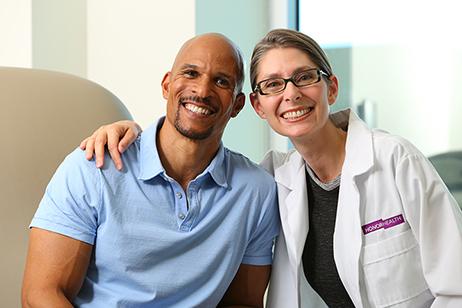DO: Doctor of osteopathic medicine
DOs practice osteopathic medicine, which is more holistic. The focus is on seeing the patient as a whole person instead of just treating their symptoms. They also practice independently.
DOs also receive training in osteopathic manipulative treatment — moving a patient's muscles and joints with stretching, gentle pressure and resistance — to diagnose, treat and prevent illness. They make up 10% of practicing physicians in the U.S. today.
Training:
- Four-year college degree
- Four years of medical school
- Internship, residency and fellowship lasting three to eight years
- Special training in the body's musculoskeletal system
Included in DO education is special training in the body's musculoskeletal system of muscles, nerves and bones.
Medical licenses are governed at the state level by state boards of medicine. In addition, there are 24 medical specialty boards that certify physicians in specialties and subspecialties.
To become board-certified, a physician needs to spend several years after medical school receiving supervised in-practice training followed by written and sometimes oral exams.
What a DO does:
- Diagnoses and manages acute and chronic illnesses.
- Orders, performs and interprets diagnostic tests, such as lab work and X-rays.
- Refers to other specialists and healthcare providers as needed.
- Prescribes medications and other treatments.
- Manages a patient's care.
- Performs operations (surgeons).
- Conducts manipulative treatment of muscles and joints.
DPM: Doctor of podiatric medicine
A DPM is a podiatrist, known also as a podiatric physician or surgeon, who receives education and training to diagnose and treat conditions affecting the foot, ankle and related structures of the leg.
Training:
- Four-year college degree
- Four years of podiatric medical school
- Three years of residency training, depending on the specialty
- Fellowship training for one or more years in some specialties
Podiatrists must be licensed, and they may choose to obtain board certification from a podiatry professional organization such as the American Board of Podiatric Medicine, the American Board of Multiple Specialties in Podiatry or the American Board of Foot and Ankle Surgery to enhance their credentials and training.
What a DPM does:
- Diagnoses and treats conditions affecting the foot, ankle and related structures of the leg.
- Recommends appropriate non-surgical options.
- Performs surgery when needed (DPMs with credentials in foot and ankle surgery).
- Offers education, exercise and footwear recommendations to prevent injury.
NP: Nurse practitioner
NPs practice in primary, acute and specialty healthcare services. They treat the whole person and guide each patient to make smart health and lifestyle choices. They do not require physician supervision to make clinical decisions, meaning they practice independently.
Training:
- Bachelor's and master's degrees in nursing
- Most graduate programs require more than five years of experience in the medical field before a candidate can apply
- PhD and/or doctorate in nursing (DNP) for some
What an NP does:
- Diagnoses and manages acute and chronic illnesses.
- Orders, performs and interprets diagnostic tests, such as lab work and X-rays.
- Refers to specialists or other healthcare providers as needed.
- Prescribes medications and other treatments.
- Manages a patient's care.
- Focuses on health promotion, disease prevention and health education and counseling.
- Practices under the rules and regulations of the state in which they're licensed and are nationally certified in the specialty areas.
- Assists surgeons in major surgeries.
PA: Physician assistant
The first PAs started training in 1967 at Duke University in North Carolina as part of a program that helped Vietnam vets who had served as medics.
PAs work in primary and specialty care under the direction and supervision of a licensed physician.
Training:
- Master's degree
- Experience as an EMT, paramedic, medical assistant or ER technician (in some cases)
- At least 2,000 hours of clinical rotations
What a PA does:
- Diagnoses and treats common illnesses and injuries.
- Performs certain procedures and minor surgeries.
- Prescribes a limited number of prescriptions.
- Orders and interprets diagnostic and lab tests (analyzes results with physicians).
- Offers guidance about health and nutrition.
- Tracks medical histories and symptoms.
- Treats minor injuries or sicknesses.
- Refers patients to a specialist and other healthcare providers.
- Assists surgeons in major surgeries.
Licensing and certification:
- Although laws vary by state, all PAs need to complete an accredited education program and pass a national exam.
MA: Medical assistant
MAs perform both clinical and administrative jobs at doctors' offices, urgent cares and clinics.
Training:
- High school diploma or equivalent
- Completion of a medical assistant program at a college, university, or vocational or technical school
- Clinical internship or externship
What an MA does:
Clinical duties
- Taking a patient's medical history.
- Explaining treatments to patients.
- Preparing a patient for examination.
- Helping the physician during exams.
- Collecting and preparing lab specimens.
- Performing basic lab tests.
- Preparing and administering medications as directed by a physician.
- Drawing blood.
- Doing electrocardiograms.
- Removing sutures and changing dressings.
- Transmitting prescription refills as directed.
Administrative duties
- Updating patient medical records.
- Coding and filling out insurance forms.
- Using computer applications.
- Answering telephones.
- Scheduling appointments.
- Arranging for hospital admissions and lab services.
- Handling correspondence, billing and bookkeeping.
Many employers prefer that medical assistants are certified by the American Association of Medical Assistants.
